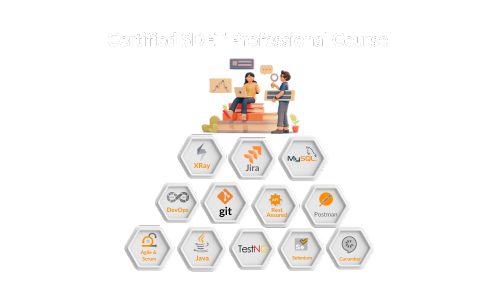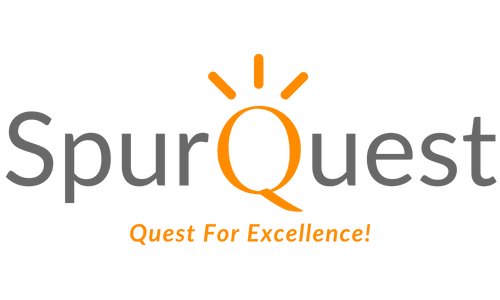Certified SDET Professional Course
Learn to build robust software testing frameworks and enhance your skills in this comprehensive training program. Our experienced trainers will guide you through the latest tools, technologies, and best practices in Agile methodologies, Core Java, Selenium, API testing, and more. Gain expertise in designing automation frameworks, collaborating with teams, and ensuring software quality. Suitable for beginners and professionals, this program offers practical training tailored to the industry. Take the first step towards becoming an expert Software Development Engineer in Test. Enroll now to advance your career or enter the field of software testing.

The software testing industry is rapidly evolving, and professionals such as testers, automation engineers, and quality engineers are embracing the transition to Certified SDET (Software Development Engineer in Test) roles through participation in the SpurQuest SDET Professional Course. Developed by industry experts, this course empowers individuals with comprehensive knowledge of software development and testing tools.
Certified SDET Professional Course is an accelerated program that covers a wide range of topics, including Core Java, SDLC, Agile & Scrum, Manual Testing, TestNG, Web Automation using Selenium, Automation Frameworks, BBD with Cucumber, API Testing with Postman, RestAssured for API Test automation, Version Control with Git & Github, DevOps & CI/CD, Database & SQL, and ALM using Jira, and the bonus class with Test Management Tool – Xray. This comprehensive curriculum enables participants to quickly become proficient SDET Professionals.
So, if you are looking to upgrade your career as a Certified SDET Professional or want to enter the field of software testing, this training program is the perfect opportunity for you. Enroll now and take the first step towards becoming an expert in Certified SDET Professional.
Chapters
SDLC, Agile & Scrum
1. SDLC Phase
2. SDLC Models
3. What is Agile
4. Agile Values – Manifesto
5. Introduction to Scrum
6. Scrum Framework
7. Scrum Roles
8. Scrum Ceremonies and Events
9. Scrum Terms and Artifacts
10. Estimation In Agile
Manual Testing
1. Why Quality?
2. Software Characteristics
3. What is Software Quality?
4. What is software testing?
5. Testing Vs Debugging
6. QA vs QC vs Testing
7. Seven Testing Principles
8. Cost of Quality
9. The Psychology of Testing
10. Test Process
11. Test Process in Context
12. Testing Throughout the Software Development Lifecycle
13. Test Case Design Techniques
14. Test Management
Core Java
1. Introduction and Installation
2. Structure of programming language
3. Control Flow Statements
4. Looping in Java
5. Object-oriented Concepts
6. super keyword
7. this keyword
8. final keyword
9. Typecasting
10. Java packages
11. Exception Handling
12. Generics
13. Collections & streams – ArrayList, Hashmaps, hashtables
14. Multithreading
15. File I/O
16. Lambda Expressions
17. Functional interfaces
18. Method References
19. Default Methods
20. Optional Class
21. Serialization
22. Garbage Collector
23. New Date/Time API
TestNG
1. Introduction to TestNG
2. TestNG Annotations
3. TestNG Test Suites
4. TestNG Parameterization
5. Data-Driven Testing in TestNG
6. Parallel Test Execution in TestNG
7. TestNG Listeners
8. Reports using TestNG
9. Final Project
Web Automation using Selenium
1. Introduction to Test Automation
2. Selenium IDE
3. Selenium WebDriver Overview
4. Locating Elements
5. Handling Multiple Elements
6. Navigation in selenium-
7. Handling Edit-box-
8. Handling Disabled Element
9. Take a Screenshot
10. Performing Scroll down Action
11. Handling Drag and Drop
12. Handling Keyboard and Mouse Actions
13. Handling Mouse Hover
14. Keyword Events using Action class
15. Handling Popups (web-based and Window-based)
16. Handling New Windows/New Tabs
17. Scrolling on a web page using JavaScript Executor
18. Types of Alerts
19. Handling links
20. Handling Radio button & Check-box
21. Handling WebTable
22. Handling Drop Down using Select class
23. Methods under Select class
24. Resize operations
25. Handling File Upload
26. What is an IFrame
27. Working with Excel
28. Handling Synchronisation issues by using implicitlyWait and Explicitly Wait
Automation Frameworks
1. Stages of Automation Framework Design
2. Automation Approach
3. How to scale Automation?
4. Explanation of Hybrid Framework
5. Design Principles
6. Design Patterns
BBD using Cucumber
1. Introduction to Cucumber and BDD
2. Writing Feature Files
3. Implementing Step Definitions
4. Running Cucumber Tests
5. Integrating Cucumber with Selenium
6. Integrating Cucumber with TestNG
7. Advanced Cucumber Topics
8. Final Project
API Testing with Postman
1. Introduction to API Testing with Postman
2. Setting Up Postman and Creating Requests
3. Creating and Managing Collections
4. API Testing with Postman
5. Advanced Postman Features
6. Integrating Postman with Newman
7. Advanced Topics in API Testing
8. Final Project
API Test automation using RestAssured
1. Introduction to API Testing with RestAssured
2. HTTP Request and Response in RestAssured
3. API Testing with RestAssured
4. Integrating RestAssured with TestNG & Cucumber
5. Final Project
Version Control, Git & Github
1. What is VCS?
2. Different types of VCS present
3. What is Git? & Why choose Git?
4. What is GitHub?
5. Difference between Git & GitHub
6. Difference between Local and Remote Branches
6. Installation of Git
7. How to create a GitHub account
8. GitHub dashboard overview
9. Creating and adding a public ssh key
10. How to create a GitHub repository and different modules to look after while creating a repo.(public/private, readme.md, gitignore, protecting the branch)
11. Git Commands
12. What is a pull request?
13. How to create a pull request?
14. What are merge conflicts?
15. How to resolve the merge conflicts?
DevOps & CI/CD
1. What is DevOps?
2. Why is it necessary for testers?
3. What is CI/CD?
4. Benefits of CI/CD
5. Different tools used for CI/CD
6. The CI/CD process flow
7. Introduction of GitHub Actions for CI/CD
8. What is workflow?
9. YAML language introduction and structure
10. Overview of the GitHub marketplace
11. How to create a workflow file?
12. What are the different components of CI/CD workflow?
13. Difference between self-hosted and GitHub cloud-hosted runner
14. Create a complete CI/CD workflow file for your repository
Database & SQL
1. Introduction to Databases
2. SQL Basics
3. SQL Joins and Subqueries
4. Overview of SQL functions and their types
5. Data Query Language (DQL)
6. Database Design and Normalization
7. Final Project
ALM using Jira
1. Introduction to ALM
2. Creating and Managing Projects
3. Creating and Tracking Issues
4. Performing Version Control with Jira
5. Using Agile Methodologies in Jira
6. Tools and Techniques for Efficient Project Management
7. Integrating Jira with Other Tools
Test Management Tool - Xray
1. Introduction to Test Management
2. Creating and Managing Test Cases
3. Creating and Managing Test Plans
4. Executing Tests in Xray
5. Generating Reports in Xray
6. Integrating Xray with Other Testing Tools
7. Advanced Topics in Xray
